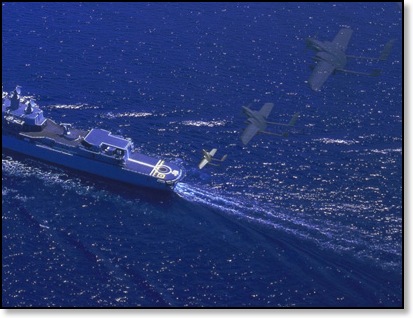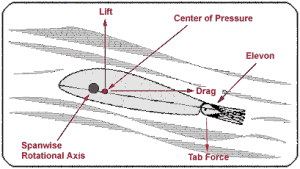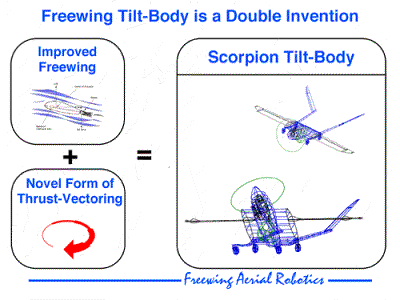Tilting the Body to Vector Thrust
Intro: How the Freewing Tilt-Body Works
The Tilt-Body is a new kind of airplane, distinct from fixed wings (since the Wrights in 1903) and from rotary wings (since Sikorsky). It is not a "forced marriage" of the two, like other thrust-vectoring aircraft. It is neither fixed wing nor rotary wing nor any combination of the two.
The Freewing Tilt-Body is really two innovations in one. In brief description, the wing is placed on bearings so that it is completely free to rotate in pitch. (Imagine a weathervane turned horizontally.) The fuselage itself is a lifting body, so the result is a left/right wing pair conjoined by a cross spar passing through the lifting body. Both the left/right wing pair and the central lifting body are free to rotate about the spanwise shaft, free with regard to the relative wind and free with regard to each other.
Just how different this is from conventional fixed wing aircraft is shown in the following chart:
Opposing Theories: Fixed Wing vs. Pivoting Wing Tilt-Body |
|||||
|---|---|---|---|---|---|
Angle of Incidence = angle of wing with regard to the fuselage |
|||||
|---|---|---|---|---|---|
Conventional Design: |
Freewing Tilt-Body Design: |
||||
|---|---|---|---|---|---|
Although a rotatable wing has been known at least since 1949, when George G. Spratt flew the first aircraft he called a Controlwing, what Freewing™ Aerial Robotics Corporation and its principals have done is first to create a pivoting wing capable of generating higher lift coefficients than previously possible, making the pivoting wing truly practical. These innovations are the subject of patents (pending and granted) by Freewing's founder. Herein we refer to the gestalt as the "improved pivoting wing." This cross section illustrates the pivoting wing principle:

Since the center of lift is behind the rotational axis, generating lift creates a negative pitching moment. But the airfoil itself has a positive pitching moment at trim. Where those pitching moments resolve themselves to zero, that is the angle of attack the wing sets and maintains. Thus it automatically adjusts to changes in the relative wind (e.g. gusts) just as weathervanes do. This means that the pivoting wing can be essentially stall-free, since the wing maintains a constant angle of attack.
It is important to note that the resulting "flying wing" has but a fraction of the pitching moment of inertia compared to an otherwise identical fixed wing vehicle. Therefore the wing responds rapidly to alleviate gust loads. Fixed wings have to drag the whole fuselage through the pitch axis to do this, but in a pivoting wing the fuselage is decoupled from the wing in pitch.
Tilt-Body: Revolutionary Improvement. The Tilt-Body is a new invention in many ways more dramatic than the pivoting wing itself. The subject of several new patents assigned to the Company, the Tilt-Body is created by adding trim tabs to the fuselage, or center lifting body. These trim tabs are in the form of long booms, which help to increase tail volume (and therefore controllability at slow speeds). But they are functionally just trim tabs. The left and right tail booms are cross connected by a lightweight torque tube. A single jackscrew acts against a control horn on this torque tube to motor the booms (i.e. fuselage trim tabs) "up and down" during flight. In fact the booms cannot pitch up and down during flight any more than an arrow can fly sideways. Dynamic pressure on the trim tabs forces the booms to stay parallel to the direction of flight; the result is that the fuselage is forced to pitch up and down as the jackscrew moves. And since the engine and propeller are in the fuselage, the thrust line also pitches up and down. In short, one achieves simple thrust-vectoring with just a few moving parts, and the totality is autostable in the bargain.

